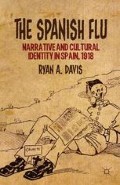Abstract
Pepita Viladanes was only two years old when the Spanish influenza epidemic broke out in 1918. Although she has no direct memory of what happened, she has noted how “it’s like I saw those scenes [first-hand] because my mother, who thanks to God is alive and remembers them perfectly, has told me about them so many times.”1 Her father and five neighbors, all of whom lived in the same house, died from Spanish flu. Since her father was among the first to go, he was able to receive a proper Christian burial. Those who died afterward, however, met with a different fate: “They lowered them down from the balconies with ropes and piled them up in carts to burn them. Volunteers did this because there were no gravediggers or at least none who wanted to do this service.”2 For Pepita’s mother, widowed at the young age of 23, the situation was nearly too much to bear: “She felt powerless to [face] the situation in the midst of so much tragedy and almost made an attempt on her own life and mine by refusing to eat.”3 Thankfully she was able to overcome the crisis, and both she and her daughter would ultimately recover “little by little.”4
Access this chapter
Tax calculation will be finalised at checkout
Purchases are for personal use only
Preview
Unable to display preview. Download preview PDF.
Notes
Beatriz Echeverri, La gripe española: La pandemia de 1918–1919 (Madrid: Centro de Investigaciones Sociológicas, 1993), 94.
María-Isabel Porras-Gallo, Un reto para la sociedad madrilenia: La epidemia de gripe de 1918–19 (Madrid: Editorial Complutense, 1997), 46.
Patrick Colm Hogan, Understanding Nationalism: On Narrative, Cognitive Science, and Identity (Columbus: Ohio State University Press, 2009), 201.
Ed Cohen, A Body Worth Defending: Immunity, Biopolitics and the Apotheosis of the Modern Body (Durham, NC: Duke University Press, 2009), 257.
Ibid. See also Donna J. Haraway, “The BioPolitics of Postmodern Bodies: Constitutions of Self in Immune System Discourse,” in Simians, Cyborgs, and Women: The Reinvention of Nature (New York: Routledge, 1991) and
Emily Martin, Flexible Bodies: Tracking Immunity in American Culture—from the Days of Polio to the Age of AIDS (Boston: Beacon, 1994).
Alfred I. Tauber, The Immune Self: Theory or Metaphor? (New York: Cambridge University Press, 1997), 9.
William C. Summers, “Microbe Hunters Revisited,” International Microbiology 1 (1998): 65.
René Dubos, Mirage of Health: Utopias, Progress, and Biological Change (Brunswick, NJ: Rutgers University Press, 1987), 1.
Neil Pascoe, “A Pandemic Flu: Not If, But When. SARS Was the Wake-up Call We Slept Through,” Texas Nursing 80, no. 1 (2006).
George Lakoff and Mark Johnson, Metaphors We Live By (Chicago: The University of Chicago Press, 1980).
Copyright information
© 2013 Ryan A. Davis
About this chapter
Cite this chapter
Davis, R.A. (2013). Conclusion: A Telling Epidemic, A Storied Nation. In: The Spanish Flu. Palgrave Macmillan, New York. https://doi.org/10.1057/9781137339218_7
Download citation
DOI: https://doi.org/10.1057/9781137339218_7
Publisher Name: Palgrave Macmillan, New York
Print ISBN: 978-1-349-46439-5
Online ISBN: 978-1-137-33921-8
eBook Packages: Palgrave History CollectionHistory (R0)

